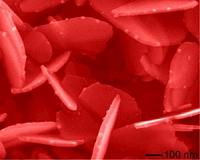 |
Tel Aviv (AFP) Nov 9, 2010 A material just one atom thick that is stronger than steel but flexes like rubber. A "mini-submarine" that can trick the immune system and deliver a payload of chemotherapy deep inside a tumour. They sound like the fantasies of science fiction writers, but they are among the discoveries being presented at Nano Israel 2010, a nanotech conference in Tel Aviv that has attracted researchers from across the science world, united by their work with the very, very small. The 1,500 participants at the two-day meeting which ends on Tuesday include chemists, physicists and medical researchers, all working with tiny structures around the thickness of a cell wall. "We are all working to be able to manipulate molecules at an atomic level," said Dan Peer, a professor at Tel Aviv University's Cell Research and Immunology Department. Physicists are developing new materials by removing or adding to existing structures and nano-medical researchers are building new ways to deliver drugs. Peer is trying to find out how to more effectively target cancer and the inflammation associated with diseases like multiple sclerosis by better directing toxic treatments like chemotherapy. "Sometimes the drug is there, but it doesn't operate in a targeted manner," he told AFP. In such cases, scientists are trying to find ways to build "GPS systems" into the drugs so they travel directly to malignant cells or inflammation. One way of doing that is to attach the cancer treatment to a vitamin that tumours happily suck up, allowing the medication to penetrate the malignant cells with ease. "You can potentially create new materials, new vehicles for drugs, like very small bubbles, like mini-submarines, which carry them into the body," Peer told AFP. Joseph Kost, a professor at Ben Gurion University of the Negev's chemical engineering department, is working on a technique that delivers chemotherapy drug Cisplatin into tumours. The drug is carried by a tiny vessel through gaps of between 100-1000 nanometres in size, giving scientists a "therapeutic warhead," he said. Once inside, researchers irradiate the drug vehicles with ultrasound, causing them to "explode" and disperse the treatment inside the tumour. Others are looking at ways to trick the body's immune system to prevent it from identifying drug treatments as invading viruses and attacking them. Elsewhere, physicists like Andre Geim, winner of this year's Nobel Prize for Physics, are using nanotechnology to develop new materials with a surprising range of applications. Geim, a Russian scientist working in Britain, presented his work on graphene, a one-atom-thick slice of graphite that is stiffer than diamond. "You can imagine you can make a thousand devices out of this graphene," he told an audience of researchers from 35 countries, whose work could one day produce more efficient conductors and roll-up touchscreens for computers. Graphene's structure could even allow it to be used for faster DNA sequencing, Geim said. For Israel, hosting the gathering of nano-researchers is a way of showcasing a sector that the government is trying to foster. "We see this as a major economic initiative for the future of Israel," said Barry Breen, a spokesman for Israel's National Nanotechnology Initiative, a government advisory body. "It should be a dominant economic engine." INNI works to match Israel's nanotech researchers with private industry. A recent project saw Jerusalem-based company 3G Solar work with scientists at Bar Ilan University to develop a solar cell that processes energy in a similar way to photosynthesis in plants. Aharon Gedanken, a professor of chemistry at Bar Ilan University, is using nanotechnology to develop sterile hospital sheets and robes using a technique called sonochemistry. The process uses a chemical reaction that produces "microjets," which throw out nanoparticles of anti-bacterial metals like zinc oxide at "such a high speed that they are embedded in the surface." The resulting fabric can be washed, even at the hospital standard of 92 degrees Celsius (197.6 degrees Fahrenheit), without losing its anti-bacterial properties. "The vision of this project is that in the future all the fabrics in a hospital will be anti-bacterial," he said.
Share This Article With Planet Earth
Related Links Nano Technology News From SpaceMart.com Computer Chip Architecture, Technology and Manufacture
 Scientist Chronicle Nanoparticle Journey From The Lungs Into The Body
Scientist Chronicle Nanoparticle Journey From The Lungs Into The BodyBoston MA (SPX) Nov 09, 2010 Using a novel, real-time imaging system, scientists have tracked a group of near-infrared fluorescent nanoparticles from the airspaces of the lungs, into the body and out again, providing a description of the characteristics and behavior of these minute particles which could be used in developing therapeutic agents to treat pulmonary disease, as well as offering a greater understanding of the he ... read more |
|
| The content herein, unless otherwise known to be public domain, are Copyright 1995-2010 - SpaceDaily. AFP and UPI Wire Stories are copyright Agence France-Presse and United Press International. ESA Portal Reports are copyright European Space Agency. All NASA sourced material is public domain. Additional copyrights may apply in whole or part to other bona fide parties. Advertising does not imply endorsement,agreement or approval of any opinions, statements or information provided by SpaceDaily on any Web page published or hosted by SpaceDaily. Privacy Statement |